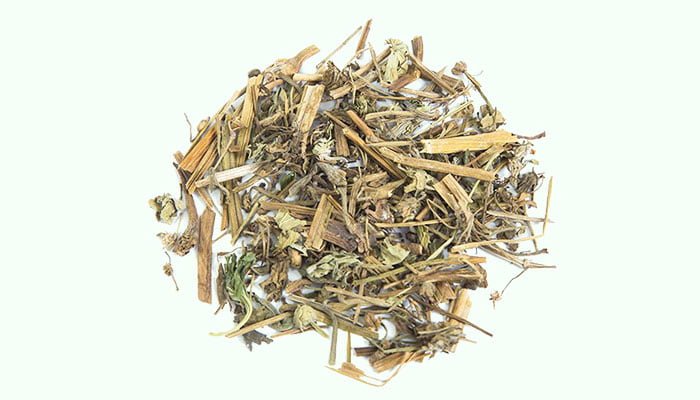What Is Lao Guan Cao
Lao Guan Cao is the above-ground part of Erodium stephanianum, Geranium wilfordii, or Geranium carolinianum, which is a herb of the Geraniaceae family. It first appeared in <Jiuhuang Bencao> (Materia Medica for Relief of Famines) in 1,406 AD.
Erodium stephanianum is a perennial herb of the genus Erodium. They often grow on hillsides, farmlands, sandy river banks, and grasslands. They are distributed in China, Mongolia, Russia, Japan, South Korea, Kazakhstan, Afghanistan, Nepal, Kyrgyzstan, Kazakhstan, Pakistan, and Tajikistan.
Geranium wilfordii is a perennial herb of the genus Geranium. They like light, warm and humid climates. They grow well in loose, fertile, moist loam soil. They often grow in low mountain forests and meadows below 1,800 meters above sea level. They can be found in China, Russia, Japan, Korea, and Poland.

Geranium carolinianum is commonly known as Carolina crane’s-bill or Carolina geranium, which is an annual herb of the genus Geranium. They often grow in weeds on plains and low hills and barren slopes. This plant is native to North America and has been introduced to China, Japan, India, and some countries in South America.
In summer and autumn, when the fruits of Erodium stephanianum, Geranium wilfordii, and Geranium carolinianum are nearly ripe, people gather their above-ground parts, remove impurities, dry them in the sun, cut them into pieces, and make them into Chinese herbal medicines.
Lao Guan Cao contains geraniin, ellagic acid, corilagin, methyl brevifolin carboxylate, ethyl gallate, chebulinic acid, chebulagic acid, brevifolin, brevifolincarboxylic acid, catechin, methyl gallate, gallotannin, methyl brevifolincarboxylate, kaempferol, quercetin, isoquercitrin, myricetin, apigenin, juglanin, scyllitol, juglalin, trifolin, avicularin, myricitrin, rutin, daucosterol, vitexin, hyperoside, astragalin, gallic acid, salicylic acid, succinic acid, protocatechuic acid, 4-hydroxybenzoic acid, caffeic acid, shikimic acid, syringic acid, ursolic acid, oleanic acid, β-sitosterol, 4-hydroxykobusin, stigmasterol, herniarin, magnolin, and caroliniaside A-C.
Generally, gray-green or purplish Lao Guan Cao with many leaves and fruits is preferred.
According to the Chinese Pharmacopoeia, the medicinal nature of Lao Guan Cao is relatively neutral, with a pungent and bitter taste. It has a certain therapeutic effect on the pathological changes of the liver, kidney, and spleen meridians.
In traditional Chinese medicine, it is often used to expel wind and dampness, activate meridians, stop diarrhea, clear heat and remove toxins, and treat rheumatic arthralgia, numbness of limbs, tendon spasm, aching pain of tendons and bones, traumatic injury, gout, sores, ulcers, eczema, empyrosis, abnormal leukorrhea, female genital itching, urinary tract infection, pelvic inflammatory disease, bacillary dysentery, the proliferation of mammary gland, and herpetic keratitis.
There are more than 30 kinds of traditional Chinese medicine prescriptions containing it, such as Qu Feng Zhi Tong Pian, Jing Dai Ning Capsules, and Kang Shen Wan.
Benefits
- Anti-inflammation, inhibiting xylene-induced ear swelling in mice and carrageenan-induced paw swelling in rats [1].
- Increasing the pain threshold and inhibiting the pain caused by the hot plate experiment and glacial acetic acid experiment in mice.
- Anti-oxidation, scavenging DPPH free radicals, superoxide anion free radicals, and nitric oxide free radicals.
- Inhibiting replication of influenza virus, HSV-1 virus, vaccinia virus, and HIV-1 virus.
- Reducing D-galactosamine-induced acute liver injury in mice and protecting the liver.
- Expelling wind and dampness, activating meridians, treating rheumatic arthralgia, numbness of limbs, tendon spasm, aching pain of tendons and bones.
- Clearing heat and treating diarrhea caused by damp-heat or heat toxins.
- Removing heat toxins, treating carbuncles, sores, furuncles caused by stagnation of damp toxins, eczema, and empyrosis.
- Geraniin can inhibit the secretion of hepatitis B surface antigen (HBsAg) and hepatitis B e antigen (HBeAg) [2].
- Its tannins have a certain inhibitory effect on Staphylococcus aureus, Streptococcus lactis, Pseudomonas aeruginosa, Escherichia coli, Shigella, and Helicobacter pylori.
- Its total tannins can reduce the number of diarrhea induced by senna or castor oil in mice, and inhibit the rate of ink gastrointestinal propulsion in normal and propulsive hyperfunction mice.
Combinations
- It can be used in combination with Wei Ling Xian (Radix Clematidis), Du Huo (Radix Angelicae Pubescentis), Hong Hua (Flos Carthami), etc. to treat rheumatic arthralgia, numbness of limbs, tendon spasm, aching pain of tendons and bones.
- It can be used in combination with Huang Lian (Rhizoma Coptidis), Ma Chi Xian (Purslane), etc. to treat diarrhea caused by damp-heat or heat toxins.
- It can be used in combination with Pu Gong Ying (Dandelion), Jin Yin Hua (Flos Lonicerae), Zi Hua Di Ding (Viola Yedoensis), etc. to treat carbuncles, sores, furuncles caused by stagnation of damp toxins.
- It can be used in combination with Ding Gong Teng (Caulis Erycibes), Sang Bai Pi (Cortex Mori), Xi Xian Cao (Herba Siegesbeckiae), etc. to treat numbness of limbs, soreness and weakness of waist and knees, arthralgia caused by wind-cold-damp.
- It can be used in combination with Hu Er Cao (Saxifraga Stolonifera), Xu Chang Qing (Radix et Rhizoma Cynanchi Paniculati), Lian Qian Cao (Glechomae Herba), etc. to treat abdominal pain during menstruation, menstrual dark color, blood clots, leukorrhea with reddish discharge, pudendal itching.
Side Effects
- At present, there are no reports in the literature that Lao Guan Cao has toxic effects, and there are no reports of serious adverse reactions when it is taken according to the prescribed dose.
Precautions and Warnings
- The dosage of Lao Guan Cao should be controlled at 9-15g.
- It can be made into decoctions, ointments, medicinal liquors, or mashed for external use.
- People who are allergic to Lao Guan Cao should not take it.
- Pregnant and lactating women should take it under medical supervision.
- It should be taken under medical supervision by kids, the elderly, and the infirm.
